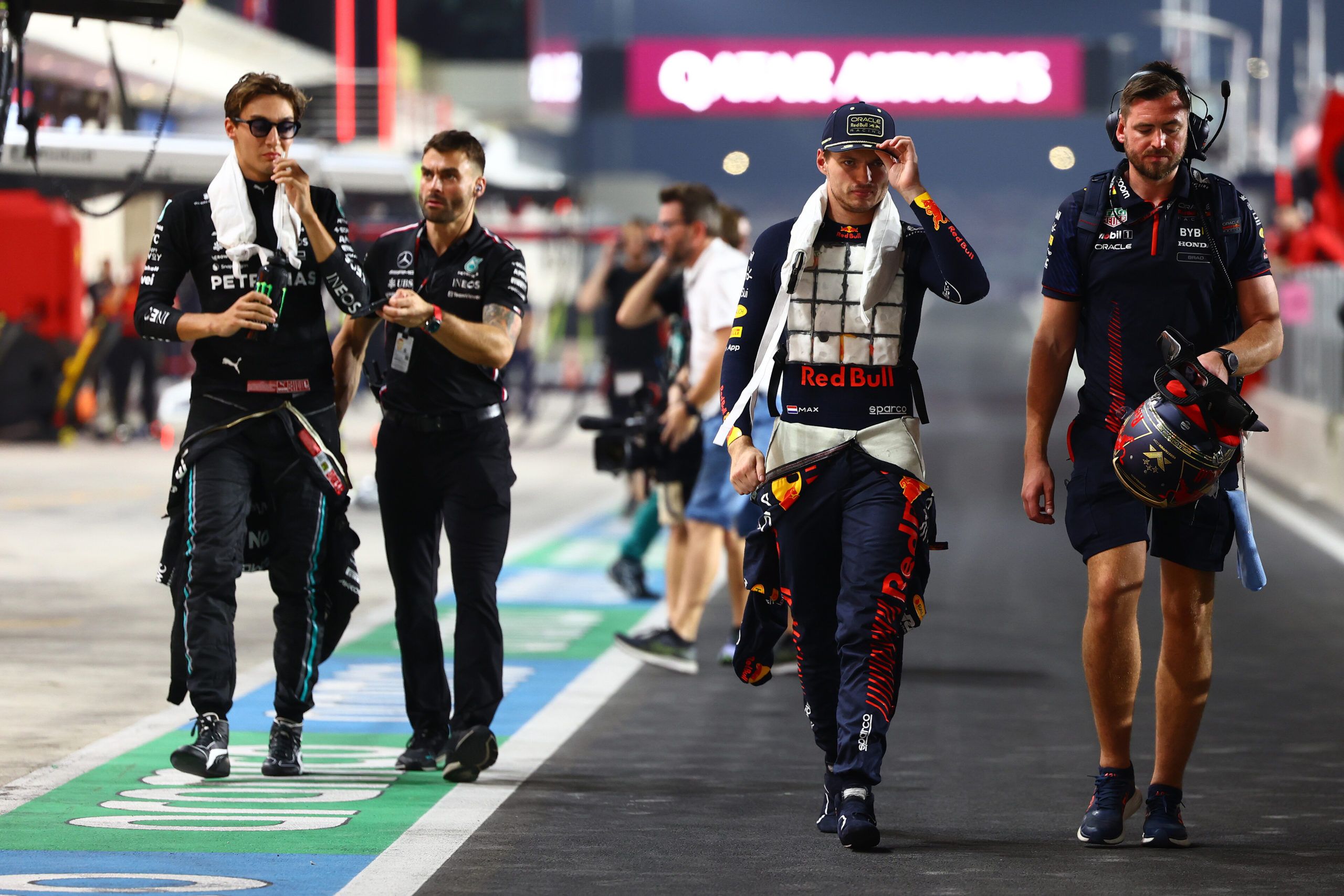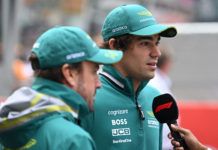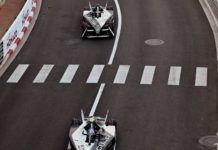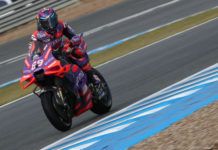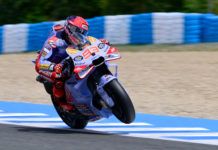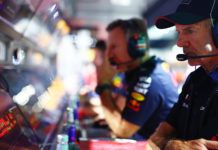The F1 drivers raise concerns about racing in extreme conditions in Qatar GP which was torture and just on the limit as FIA initiates analysis.
At least four drivers paid a visit to the medical center post the F1 Qatar GP which had several having problems even getting out of their cars in the parc ferme. Williams’ Logan Sargeant was forced to retire due to dehydration while many thought about the same.
Almost every driver needed some rest post the end with the Top 3 also seen laying down in the cool down room to relax. The heat and humidity was extreme in Qatar with no wind which had F1 drivers opening their lids and or raising their hands to get some air.
The concerns are being heard by the FIA who have initiated an analysis into the F1 grand prix which was also marred by kerbs issues that led to mandated laps set by the governing body and Pirelli on safety grounds – which was first of a kind.
The matter will be taken up in the FIA’s meet in Paris. While next year’s Qatar GP is scheduled to take place on December 1 when it will be cooler, the governing body wishes to avoid such scenarios still where several measures will be discussed – even to the extent taking solutions from other championships.
FIA: “The FIA notes with concern that the extreme temperature and humidity during the 2023 FIA Formula 1 Qatar Grand Prix had an impact on the wellbeing of the drivers. While being elite athletes, they should not be expected to compete under conditions that could jeopardise their health or safety. The safe operation of the cars is, at all times, the responsibility of the Competitors, however as with other matters relating to safety such as circuit infrastructure and car safety requirements, the FIA will take all reasonable measures to establish and communicate acceptable parameters in which Competitions are held.
“As such, the FIA has begun an analysis into the situation in Qatar to provide recommendations for future situations of extreme weather conditions. It should be noted that while next year’s edition of the Qatar Grand Prix is scheduled later in the year, when temperatures are expected to be lower, the FIA prefers to take material action now to avoid a repeat of this scenario. A number of measures will be discussed at the upcoming medical commission meeting in Paris.
“Measures may include guidance for competitors, research into modifications for more efficient airflow in the cockpit, and recommendations for changes to the calendar to align with acceptable climatic conditions, amongst others. Research from other series, such as cross-country events in extreme climates, will be examined for potential applications to circuit events. The FIA’s commitment to closer cooperation between technical, safety and medical departments under the leadership of the FIA President will facilitate this process.”
Here’s what the F1 drivers said –
Lando Norris: “I think we probably found the limit. I think it’s sad we had to find it this way. It’s never a nice situation to be in, you know, some people ending up in the medical centre or passing out, things like that. So, pretty dangerous thing to have going on. But it’s not a point where you can just go, the drivers need to train more or do any of that, you know. We’re in a closed car that gets extremely hot in a very physical race. And it’s frustrating. I guess on TV, it probably doesn’t look very physical at all, but clearly, when you have people who end up retiring or in such a bad state, it’s too much, you know, for the speeds we’re doing. It is too dangerous. I know that this race next year is later on in the season, and it will be a lot cooler a few months later, but it’s something that needs to be thought of and I’m sure we’ll speak about it because it shouldn’t have happened in the first place.”
Max Verstappen: “Yeah, when I saw the weather before coming here, I was not looking forward to it. It’s just too warm, and like Lando said it has nothing to do with more training or whatever. I think some of the guys who were struggling today are extremely fit, probably even fitter than me, but just the whole day it’s like you’re walking around in a sauna and, yeah, also then in the night the humidity goes up. The races are quite long. But it’s not the only place. There are a few places like that. I think Singapore is almost like a two-hour race. And it’s very, very warm. I think it’s also quite on the limit of what is what should be allowed. So there are a few things to look at. But this was definitely way too hot. The feeling in the car was definitely very, very warm than Singapore. So yeah, I don’t think that was good.
Oscar Piastri: “Yeah, I’m very glad that we’re coming back later next year. I think today is also probably been hotter and more humid than the last couple of days. So that’s not helped things. I think Thursday was like four or five degrees hotter than it was today. So in that sense, we’re almost a little bit lucky, it wasn’t worse. But yeah, definitely the toughest race I’ve done. And yeah, obviously we need some discussions, I think about a lot of things from this weekend. But, yeah, obviously, it’s not a good situation to be in.”
Charles Leclerc: “It was the toughest race for every driver in F1 of our career – for everybody, no exception and I don’t believe the one that says it’s not. I think there were many things adding up. Obviously, the heat was extremely warm, we have a track where there are lots of high-speed corners. But I think the most significant part is the fact that we had to do three stops and that meant no tyre management in the high speed, which meant quali laps after quali laps. This, I think, maybe next year if we find ourselves in the same situation we’ll have to discuss in between us drivers. We can always look at each other at the end of the race when we are sat down and this time you could feel it was different. Some drivers really felt bad.
“The conditions were so tough drivers found it difficult to see at times. This is something we maybe will have to discuss because at one point, it’s not even a physical preparation, it’s just dehydration at such a level that you and your vision is so much worse. Your heart rate is going to the stars and it’s very difficult to control all of this so it was really, really difficult. It’s difficult to put into words and to explain how tough it is. Especially with the G-forces. When you have a lot of dehydration you can drink, but the drink is more tea than anything else because it’s at 60-plus degrees. So it’s extremely difficult to hydrate yourself and again, with the G-forces you don’t see as well.”
Fernando Alonso: “I think it was one of the hardest for sure. I think Malaysia, when we were racing in Sepang in daytime, I remember those to be very extreme. I think Bahrain 2009, it was like 41 degrees. It was extremely hot, that one. And I think this one, for sure in the top three. It was a surprise to be honest because it was not that bad in the free practice. Maybe it was windy or something and we missed that wind or something, that ventilation. So it was extreme. We need to see if in the future there is any solution and in some extreme conditions we can agree on delaying the start or whatever. I think for Lance and myself, both of us, we were struggling a little bit with temperature in the seat on the right-hand side. I got like burned in the first 15 laps so I even asked on the radio if they could throw me some water or something at the pit stop, which apparently is not allowed.”
George Russell: “I’ve just been in an ice bath and it goes to my bones and now suddenly I’m shivering. It was an absolutely brutal race, by far the most physical race I’ve ever experienced. I felt close to sort of fainting in that race. I’ve never experienced anything like it before. It was beyond the limit, I think, of what was acceptable for driving. If over 50% of the grid were saying they’re feeling sick, couldn’t drive, close to passing out – you don’t want to be passing out when you’re driving 200 miles an hour down the straight and that’s how I felt at times. Any hotter I think I’d have retired because my body was going to give up.”
Valtteri Bottas: “I would say harder than Singapore. The temperature in the cockpit starts to be almost too much, I think it’s getting to the limit that somebody is going to have a heatstroke. Honestly, the feeling is like torture in the car. Every driver will try to complete the race. You’re not going to stop if you still can drive. But at some point it becomes unhealthy and risky. Any hotter than this would be not safe. I wouldn’t go hotter than this.”
Esteban Ocon: “I was not expecting for the race to be that hard. I can normally do two race distances, even in Singapore. Physically, like muscle-wise and cardio-wise, I’m always fine. It was just like 80C inside the cockpit this race. I don’t think we probably do the best job in terms of not keeping the heat in the back, but dissipating it inside the cockpit where the driver drives, and I think that was probably the reason today why we felt so bad. But yeah. Glad that we finished the race.”
Lance Stroll: “It was lot harder than Singapore. I don’t know. Maybe they like it as part of the show. But yeah, I think it’s a combination of things. It’s the track limit thing. Having to focus like that, the time of year we come here, the temperature is too much. Maybe there is some kind of ventilation system, we have to look into for this kind of hot races like Singapore and here as cars are getting stiffer, heavier – it’s a smooth track but you can feel the stiffness of the cars when you’re riding over kerbs and stuff and I think that’s a big part of the physicality. It’s just the ride, these cars being so harsh and the G-Force being so high, it makes it really challenging. Maybe it’s just something we have to address, think about going softer cars, some kind of ventilation system we bring to these kinds of races at these temperatures. And spend more time in the sauna, I guess!”
Kevin Magnussen: “It was the hardest race for sure because it was so warm.”
Here’s F1 drivers on medical center visit and more on faints, vomits
Here’s how F1 Qatar GP panned out

